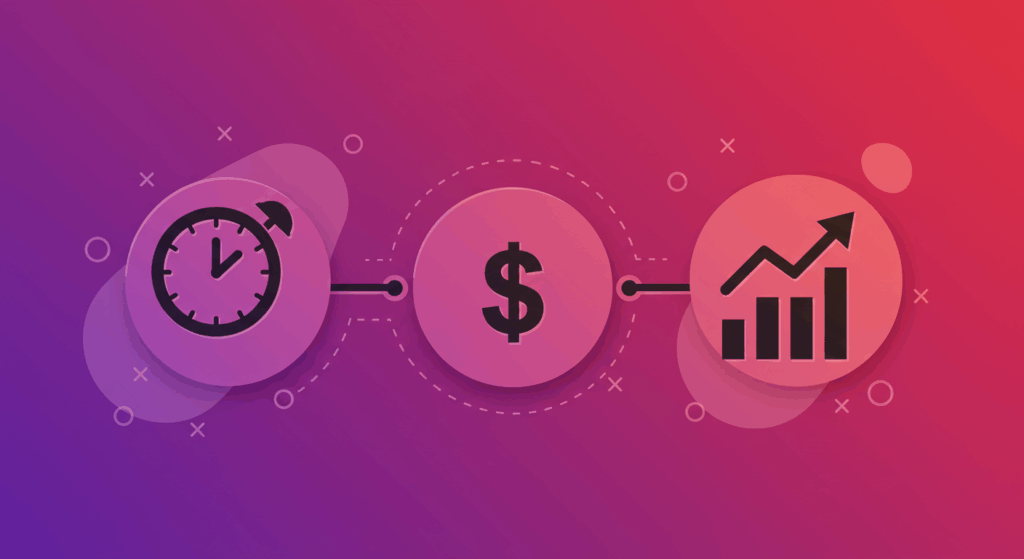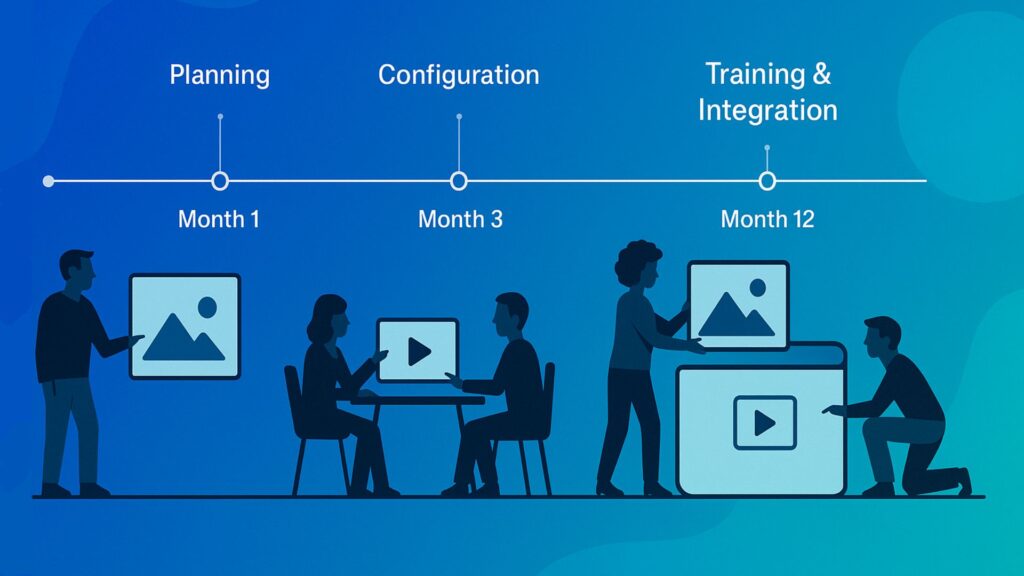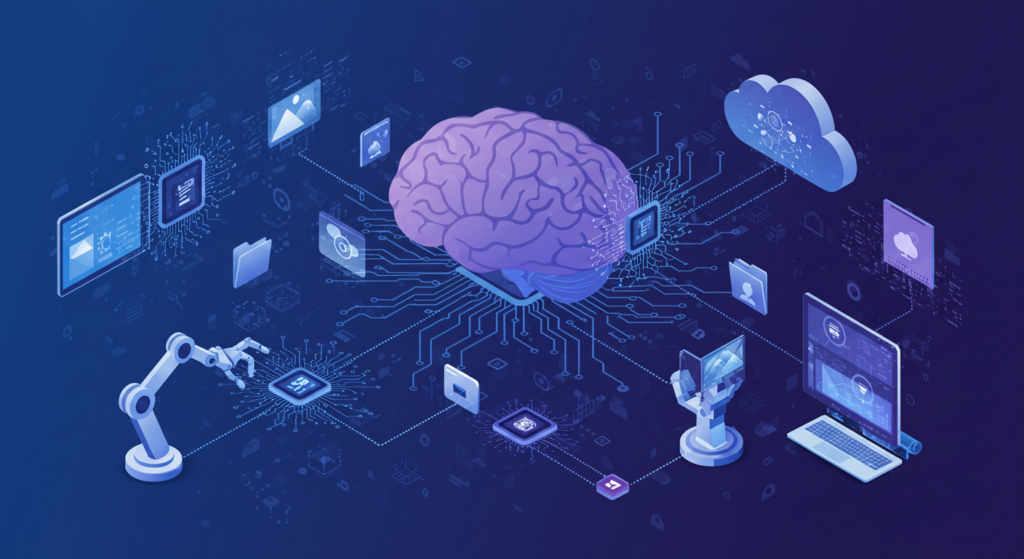DAM software delivers significant ROI through streamlined workflows and eliminated inefficiencies.
- Teams waste 20% of their time searching for assets (costing $20,000+ annually per 10 employees).
- Many organizations still lack standardized metadata or file naming conventions, which directly impacts asset findability.
- Large portions of knowledge workers end up recreating assets because they can’t locate the originals.
Use our ROI calculation methods below to build your business case and justify DAM investment with measurable returns.
The digital asset management market is projected to hit $10.3 billion by 2029, and it’s not hard to see why. Companies everywhere are drowning in digital content and finally realizing they need better ways to manage it all. Companies across industries are implementing DAM systems to improve content operations, yet not all teams fully realize the digital asset management ROI potential from their investment.
The key to maximizing DAM software ROI lies in proper planning, realistic expectations, and understanding exactly how DAM benefits translate into measurable business value. When organizations approach DAM implementation strategically, they can achieve remarkable returns on their investment while transforming their content operations.
How Do You Calculate Digital Asset Management ROI?
When it comes to understanding digital asset management ROI, there are three main ways to crunch the numbers. Each one shines a light on different ways DAM creates value for your business. Each approach reveals how DAM software delivers measurable returns through improved efficiency and reduced operational costs.

Method 1: Time-Savings ROI Calculation
The easiest way to calculate DAM software ROI? Look at how much time people waste hunting for files. It’s usually eye-opening. Employees spend an average of 20% of their workweek looking for information, which translates directly to productivity losses.
Step-by-step calculation:
- Identify users: Count employees who regularly search for digital assets
- Calculate time spent: Multiply weekly hours spent searching × hourly wage
- Apply DAM efficiency: Estimate 50-70% reduction in search time
- Annual savings: Weekly savings × 52 weeks
Example: A marketing team of 10 employees earning $25/hour each, spending 4 hours weekly searching for assets:
- Current annual cost: 10 employees × 4 hours × $25 × 52 weeks = $52,000
- With 60% time reduction: $52,000 × 0.6 = $31,200 annual savings
- DAM investment cost: $15,000 annually
- ROI = ($31,200 – $15,000) ÷ $15,000 = 108%
Method 2: Asset Recreation Cost Analysis
The second method calculates DAM benefits by measuring costs avoided through better asset findability and reuse.
Key variables to track:
- Number of assets recreated monthly
- Average cost per asset creation (internal labor + external agencies)
- Asset recreation frequency reduction with DAM
- Value of improved asset lifecycle management
Sample calculation:
- Monthly asset recreation: 50 assets
- Average recreation cost: $200 per asset
- Annual recreation cost: $120,000
- DAM reduces recreation by 70%: $84,000 savings
Method 3: Productivity and Revenue Impact
The third approach examines how improved content operations directly impact business outcomes through faster campaign execution and enhanced collaboration efficiency.
Measurable factors include:
- Reduced campaign launch timelines
- Increased content reuse rates
- Improved brand consistency metrics
- Enhanced compliance and reduced legal risks
Organizations implementing comprehensive DAM strategies often see faster campaign executions, directly translating to competitive advantages and revenue protection.
What Factors Influence DAM Budgeting and Investment Planning?
Getting real ROI from your DAM means knowing exactly what you’re getting into cost-wise. We’re talking about everything from implementation through day-to-day operations. DAM budgeting extends beyond software licensing to encompass implementation, training, and maintenance expenses.

Primary Cost Categories
Software Licensing: DAM pricing varies widely depending on scale, including the number of users, storage, hosting model (cloud vs on-premise), feature set, integrations, and support. For enterprise setups, many DAM systems exceed $50,000 per year in licensing and subscription fees.
Implementation Services: Initial services for setup, migration, configuration, custom integrations, and onboarding can form a substantial portion of the first-year cost. For more complex environments (large asset libraries, multiple integrations), projects often require tens of thousands of dollars in professional services.
Training and Change Management: User adoption directly impacts DAM benefits realization. Budget 10-15% of total investment for comprehensive training programs and change management support.
Hidden Costs to Consider
Storage and Bandwidth: While many DAM solutions include base storage, organizations with large video libraries or high-resolution assets may face additional storage costs. Plan for 20-30% annual growth in storage needs.
Integration Expenses: Connecting DAM systems with existing marketing technology, creative tools, and content management systems may require additional licensing or development costs.
Maintenance and Updates: Factor in ongoing system maintenance, security updates, and feature enhancements that ensure continued DAM software ROI optimization.
ROI-Focused Budgeting Strategy
Here’s what the smartest companies do: they set specific ROI goals before they even start shopping for DAM solutions. No vague promises, just concrete numbers they can track. Start with conservative estimates and build business cases around easily quantifiable benefits like time savings and reduced asset recreation.
Annual DAM pricing typically offers 10-20% savings compared to monthly plans, making annual commitments attractive for organizations confident in their DAM strategy.
Real-World Digital Asset Management ROI: Proven Case Studies
Want to know if DAM really delivers on its ROI promises? Look at what other companies have actually achieved. Real results from real businesses tell the whole story.
Hachette Book Group: From Chaos to 2-Hour Migration Success
Hachette Book Group (HBG), owned by the world’s third-largest publishing company, faced a challenge with over 600,000 digital assets managed in a system so complex that employees avoided using it entirely. The result was duplicated content, security risks, and hours wasted searching for assets.
The transformation results were remarkable. HBG completed their entire DAM migration over a single weekend, switching from their legacy system on Friday and launching Aprimo’s platform on Monday. “We went down from one system on a Friday and then started a new system on Monday,” said Nick Rourke, Director of Publishing Products. “The next day, Aprimo started distributing thousands of book covers.”
The immediate DAM benefits included:
- Seamless user adoption: Many users declined training because the system was intuitive
- Enhanced security: Direct asset sharing eliminated insecure file transfers
- Real-time distribution: Critical assets reached retail websites reliably and quickly
- Improved productivity: Users could find and share files without downloading and re-uploading
Bank of America: Managing $1.2 Billion Marketing Budget
Bank of America’s Corporate Marketing and Communications team needed to optimize marketing procedures while improving visibility across their massive marketing operations. The implementation of productivity management and planning solutions delivered measurable digital asset management ROI across multiple metrics.
Quantified results included:
- 27% reduction in project approval timelines
- 33% faster invoice processing in the first year
- $1.2 billion marketing budget managed through the platform
- 600+ users and 12 external agencies coordinated efficiently
- 3,000+ sponsorship activities tracked and managed
“We needed a standard project management approach for marketing the company and to decrease cost and cycle time,” explained the Communications Manager. The platform enabled data-driven decisions and comprehensive tracking that previously required multiple disconnected systems.
Additional Industry Success Stories
Healthcare System Transformation: A major healthcare network reported that their previous DAM was “lackluster” and failed to meet the needs of communications, marketing, and digital teams. After implementing an intelligent DAM solution, they achieved better search capabilities, smart tagging, and comprehensive content management that no competitor could match.
Manufacturing Efficiency: Consumer manufacturers using DAM software have reported improvements in content creation speed and significant reductions in asset duplication across global teams.
What DAM Benefits Drive the Highest ROI?
Not all DAM features pack the same ROI punch. Knowing which ones deliver the biggest returns helps you focus on what actually matters for your team.. The highest impact areas consistently generate measurable value across industries.
Enhanced Content Discoverability
Modern DAM systems with AI-powered search capabilities dramatically reduce the time teams spend locating assets. Natural language search, predictive metadata, and intelligent tagging enable users to find relevant content in seconds rather than hours.
ROI drivers include:
- 72% faster asset findability with AI search
- Improved content reuse rates through better discoverability
- Reduced asset recreation due to “lost” content
Automated Workflow Efficiency
Workflow automation is one of the highest value DAM benefits for organizations managing complex approval processes. Automated notifications, routing, and status tracking eliminate manual coordination efforts.
Key productivity gains:
- Streamlined review and approval cycles
- Reduced project management overhead
- Improved collaboration across distributed teams
Brand Consistency and Compliance
DAM systems serve as central repositories for approved brand assets, ensuring consistent messaging across all channels. Centralization prevents off-brand content usage and supports regulatory compliance requirements.
Business value includes:
- Protected brand reputation through consistent asset usage
- Reduced compliance risks and associated legal costs
- Simplified brand guideline enforcement
How Long Does It Take to See DAM ROI?
Good news: you won’t wait forever to see returns from your DAM investment. Most companies start seeing real benefits within three to six months, with the full payoff usually showing up by year one. The timeline depends on several factors that smart organizations can influence through proper planning.

Quick Wins (Month 1-3)
Immediate productivity gains occur once users begin leveraging centralized asset storage and basic search functionality. Teams experience faster asset location and reduced email-based file sharing almost immediately.
Early efficiency improvements include streamlined workflows for common tasks like asset approvals and distribution. Organizations often see measurable efficiency gains in routine content operations within the first few months of DAM adoption.
Sustained Returns (Month 4-12)
Advanced feature adoption drives more significant returns as teams master intelligent search, automated tagging, and workflow customization. Content reuse rates typically improve substantially during this phase.
Organizational transformation occurs as DAM systems become integrated into daily workflows and content planning. Teams develop more efficient content creation processes and better collaboration patterns.
Factors That Accelerate ROI
Leadership support and clear communication about DAM benefits impact adoption speed and success. Organizations with executive champions see faster user engagement and higher returns.
Comprehensive training programs ensure teams can effectively leverage advanced DAM features. Professional services partnerships can accelerate both implementation and user proficiency.
Integration planning that connects DAM systems with existing creative tools and marketing technology creates seamless workflows that maximize productivity gains.
What Are Common DAM ROI Challenges, and How Do You Avoid Them?
Sure, DAM ROI is totally achievable—but there are some traps that can trip you up along the way. Knowing what they are helps you steer clear. Understanding these challenges helps organizations avoid costly mistakes and maximize their DAM software investment.
Insufficient User Adoption
The most significant threat to DAM benefits realization is poor user adoption. Systems that teams find complicated or unhelpful quickly become underutilized, drastically reducing ROI potential.
Prevention strategies:
- Choose intuitive platforms that require minimal training
- Involve end-users in selection and configuration processes
- Provide comprehensive onboarding and ongoing support
- Establish clear governance policies that encourage system use
Inadequate Content Migration Planning
Organizations often underestimate the complexity and importance of migrating existing content into new DAM systems. Poor migration strategies can delay benefits and frustrate users.
Best practices include:
- Audit existing content libraries before migration
- Develop consistent metadata schemas and naming conventions
- Plan migration in phases to minimize disruption
- Partner with experienced implementation specialists when needed
Limited Integration Strategy
DAM systems deliver maximum value when integrated with existing creative and marketing tools. Standalone implementations miss opportunities for workflow automation and seamless user experiences.
Integration priorities:
- Creative software like Adobe Creative Suite
- Marketing automation and campaign management platforms
- Content management systems and web publishing tools
- Collaboration platforms teams already use daily
How Do You Build Your Digital Asset Management ROI Business Case?
Building a business case that actually gets approved? You need hard numbers AND a clear vision of where you’re headed. One without the other just doesn’t cut it. The most successful proposals demonstrate both immediate returns and long-term competitive advantages.
Executive Summary Framework
Start with a clear problem statement that quantifies current inefficiencies and their costs. Use the calculation methods outlined above to establish baseline costs and projected savings.
Include specific metrics:
- Current time spent searching for assets (hours per week × hourly rates)
- Asset recreation costs and frequency
- Brand consistency challenges and associated risks
- Competitive disadvantages from slow content operations
ROI Calculation Worksheet
Provide detailed calculations using conservative estimates to build credibility. Include sensitivity analyses showing ROI outcomes under different scenarios.
Essential calculations:
- Time savings from improved asset findability
- Cost avoidance through reduced asset recreation
- Productivity gains from workflow automation
- Risk mitigation through better brand control
Implementation Timeline and Milestones
Demonstrate realistic expectations by outlining implementation phases and expected timelines. This helps manage expectations while showing a systematic approach to value creation.
Key milestones include:
- Initial system deployment and basic functionality
- User training completion and adoption metrics
- Advanced feature implementation and optimization
- Integration completion and workflow automation
How Do You Maximize Long-Term DAM Software ROI?
Sustaining and growing digital asset management ROI requires ongoing optimization and evolution. Organizations that treat DAM as a continuous improvement initiative rather than a one-time implementation achieve the highest long-term returns.
Continuous User Education
DAM platforms evolve constantly with new features and capabilities. Organizations should budget for ongoing training and user education to ensure teams leverage the latest functionality.
Regular training programs help users discover time-saving features they might otherwise miss while reinforcing best practices that maximize system value.
Performance Monitoring and Optimization
Successful DAM implementations include regular performance reviews that measure actual ROI against projections. These analyses identify optimization opportunities and justify additional investment in advanced features.
Key performance indicators include:
- Asset search and retrieval times
- Content reuse rates and asset lifecycle metrics
- User adoption and engagement levels
- Campaign execution speed improvements
Strategic Feature Expansion
As organizations mature in their DAM usage, they often discover opportunities to expand system functionality in ways that drive additional returns. Advanced AI capabilities, personalization features, and deeper integrations can unlock new value streams.
Consider DAM budgeting as an evolving investment rather than a fixed cost. Organizations that expand their DAM capabilities often see accelerating returns as system value compounds over time.
Frequently Asked Questions
What is a typical ROI timeline for DAM implementation? Most organizations see initial productivity gains within 3-6 months, with full ROI realization typically achieved within 12 months. Quick wins include faster asset search and reduced email-based file sharing.
How do you measure DAM ROI for creative teams specifically? Focus on time savings from asset search, reduced asset recreation costs, and improved collaboration efficiency. Creative teams often see improvements in content production speed.
Can digital asset management ROI be measured for compliance and risk management? Yes, through reduced legal review times, decreased compliance violations, and avoided brand reputation costs. These qualitative benefits often represent substantial but harder-to-quantify returns.
What factors most influence DAM software ROI success? User adoption rates, system integration depth, and ongoing optimization efforts are the strongest predictors of ROI success. Organizations with executive sponsorship achieve consistently higher returns.
Your Path to Proven DAM ROI
Digital asset management ROI is achievable for organizations that approach DAM implementation strategically. The combination of time savings, productivity improvements, and risk mitigation creates compelling returns that justify DAM software investment.
The key to success lies in understanding your organization’s specific needs, calculating realistic ROI projections, and choosing a platform that grows with your business. Whether you’re managing thousands of assets like Hachette Book Group or billions in marketing spend like Bank of America, the right DAM solution transforms content operations from a cost center into a competitive advantage.Contact Aprimo to explore how our AI-powered content operations platform can deliver measurable returns for your business while transforming how you create, manage, and deploy digital content at scale.


